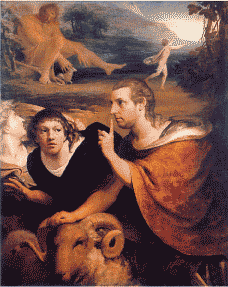David Hockney’s theory explaining that the French “neo-classicist” painter Jean-Dominique Ingres (1780-1867) was using a “camera lucida” as a guide for his work illustrates how artless the prejudices of the contemporary art-criticism are.
No doubt that Hockney and his million-dollar “masterpieces” is one of the contemporary pop-art popes. How could not be such a successful artist trusted by a majority of art-collectors?
* Although not only one qualified historian approved this teleological theory but mostly "art-dealers" or critics involved in the business, D. Hockney published and sold a book trying to convince of it’s seriousness. It is difficult to estimate the influence of Hockney’s opinion, but the fact is that he sold a lot of books. Secret Knowledge was even translated in French and some art teacher’s are teaching it uncarefuly.
Choosing Ingres as an example proves that Hockney is not realy aware of what he is promoting. This example is particularly bad because the Master of Montauban is well known to have tried to imitate Raphael’s method, the less "photographic painting" ever painted.
In this way, Ingres is fighting especially against the Dutch painting which uses the “chiaroscuro” as a dramatic effect -too much in his mind.
In the old philosophic dispute between “drawers” and “colourists”, starting from the Renaissance until the XIXth century, which can be translated in the XIXth as the fight between “classicism” (the drawing) and “romantism” (the colour), Ingres takes place in the camp of “drawers”.
The choice of Ingres is to defend the drawing as the “honesty of art”, to use the colour as anything else than “one way of”, not as a “goal”.
Thus, the master from Montauban misprizes the impression of light and shade, on which the mechanical process of a “camera lucida” or a Daguerreotype is based on.
More than that, Ingres indicated to his pupils not to compose their workings like some famous Dutch painter (as Rubens or Vermeer) did. In this respect, Rembrandt is viewed by Ingres as a good little master, not more, compared to the classical Italians, Raphael or Michelangelo, who are in the Pinnacle.
J. Vermeer was probably using a lens to help him to create the depth of focus which caracterizes most of his pieces. Its a non-sense for Ingres, an inversion in a method which is promoting the beautiful shape, the beautiful body and the balance, inspired by the Greek sculpture.
Because of the triumph of romantism over classicism, the criticism of Rubens work by Ingres is difficult to admit and even understand now. But this is a key of art history far more intersting than Hockney's ridiculous speculations upon old master's using of a camera lucida. The shame on the european University to let this kind of theory swell.
*
At this point, it is important to understand that Hockney’s “photographic point of view” on old masters is not especially his own.
It would be too simple to think that D. Hockney was only envious of Ingres’ talent so that he deduced that Ingres was benefiting of a miraculous mechanical process (“Genious ex Machina”).
The prejudice of D. Hockney is obviously determinated by G.W.F. Hegel famous and thick treatise on Aesthetic (1827-1830) too. This is the more complete romantic system. None of the self-styled “post-modern” philosophers comes out of the orbit of Hegel.
Even if Hegel understand that there is more in old master’s painting than a raw standard-measure of shape based on light and shade, he is conferring an autonomous power to light in his ambiguous romantic language. In Hegel’s explanation, the light becomes a subject, the light is seen as a “Spirit”.
It is rather interesting to observe that Hegel, who studied modern politics and right too, is doing exactly the same in these subjects, idealizing the State, seing the State as God! The German thinking from which the US thinking comes.
The more curious result of this Hegel’s aesthetic principle is that, starting from the Idea, Hegel is conjuring the abstract thinking of the painting away in the end! Taking the highway of History the wrong way, Hegel is discovering the Progress.
Of course Hegel’s theory is more balanced than Hockney's one, because he is not seeing the nature only as a "shape drawed by the light and shadows". But no doubt that Hegel has a big influence on contemporary art philosophy.
*
Is it just a tempest in a glass of water? The best way to appreciate it is to ask the question differently, as following: “Would have the art of Hockney been different without such prejudices on the art history?”
In my opinion, there is no doubt that great painters “paint as they think” that is to say that they are influenced by new ideas and new scientific discoveries after a while. Philosophy and Science are part of the principles of the European Renaissance movement to which Ingres refers constantly. It is the reason of the interest of great masters like Leonardo or Albert Durer for humanist philosophy.
A few signs coming from Russia are indicating that there is a political willing in the Eastern part of Europe to do it new. On different basis.
Russian painters and collectors seem to be attracted like Ingres was, after his revolutionary master Jacques-Louis David (1748-1825) by the Italian Renaissance. As the Italian classicism is characterized by a scientific bias, in this perspective Russian artists should go beyond naives theories on art and be more confident in historians to give them a better and faster progress.
